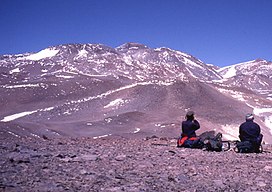
Sierra Nevada, also known as Sierra Nevada de Lagunas Bravas, is a major ignimbrite-lava dome complex which lies in both Chile and Argentina in one of the most remote parts of the Central Andes.

Nevado Ojos del Salado is a dormant complex volcano in the Andes on the Argentina–Chile border. It is the highest volcano on Earth and the highest peak in Chile. The upper reaches of Ojos del Salado consist of several overlapping lava domes, lava flows and volcanic craters, with an only sparse ice cover. The complex extends over an area of 70–160 square kilometres (27–62 sq mi) and its highest summit reaches an altitude of 6,893 metres (22,615 ft) above sea level. Numerous other volcanoes rise around Ojos del Salado.

Aracar is a large conical stratovolcano in northwestern Argentina, just east of the Chilean border. It has a main summit crater about 1–1.5 kilometres (0.6–0.9 mi) in diameter which sometimes contains crater lakes, and a secondary crater. The volcano has formed, starting during the Pliocene, on top of a lava platform and an older basement. Constructed on a base with an altitude of 4,100 metres (13,500 ft), it covers a surface area of 192.4 square kilometres (74.3 sq mi) and has a volume of 148 cubic kilometres (36 cu mi). The only observed volcanic activity was a possible steam or ash plume on March 28, 1993, seen from the village of Tolar Grande about 50 km (31 mi) southeast of the volcano, but with no evidence of deformation of the volcano from satellite observations. Inca archeological sites are found on the volcano.

Monte Pissis is an extinct volcano on the border of La Rioja and Catamarca provinces, Argentina, 25 km (16 mi) from the Chilean border. The mountain is the third-highest in the Western Hemisphere, and is located about 550 km (340 mi) north of Aconcagua. Monte Pissis is named after Pedro José Amadeo Pissis, a French geologist who worked for the Chilean government. Due to its location in the Atacama Desert, the mountain has very dry conditions but there is an extensive glacier

Incahuasi is a volcanic mountain in the Andes of South America. It lies on the border of the Catamarca Province of Argentina and the Atacama Region of Chile. Incahuasi has a summit elevation of 6,621 metres (21,722 ft) above sea level.

Cerro Solo is a large stratovolcano on the border between Argentina and Chile, west of Ojos del Salado with an elevation of 6,215 metres (20,390 ft) metres. It consists of nine eruptive centers and is covered in light-colored rhyodacite pyroclastic flow deposits.

Nevado San Francisco, or Cerro San Francisco, is a stratovolcano on the border between Argentina and Chile, located just southeast of San Francisco Pass. It is considered extinct and is one of the several 6,000 m (19,700 ft) peaks in the area, of which the chief is the Ojos del Salado. It is on the border of 2 provinces: Argentinean province of Catamarca; Chilean province of Copiapo.
Ramada is a group or massif in Argentina. It has a height of 6,384 metres (20,945 ft). It's located at Calingasta Department, San Juan Province, at the Cordillera de la Ramada.
Cerro El Toro is a mountain in the Andes located on the border between Argentina and Chile. It has an elevation of 6,168 m above sea level. Its territory is within the Argentinean protection areas of Provincial Reserve San Guillermo. The Argentinean side is at San Juan province, commune of Iglesia. Chilean side is at the Huasco province, and commune of Alto del Carmen.
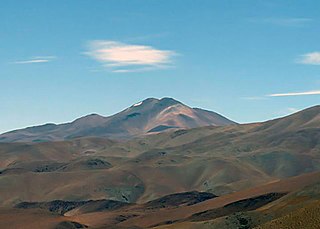
Nevado Queva or Quewar is a volcano in the Andes mountain range of South America, located in the Salta Province of Argentina. Queva has a summit elevation of 6,140 metres (20,144 ft) above sea level. Its name is alternately spelled Quehuar. There are extensive pre Columbian ruins on the summit of the mountain, which is a broad crater.
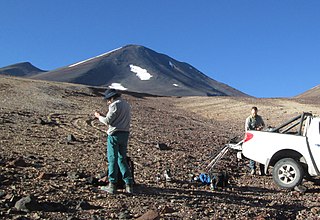
Cerro Vicuñas is a volcanic mountain in the Andes of Chile which lies immediately north of Ojos del Salado. It has a height of 6067 metres. Vicuñas if often used as acclimatisation peak before major peaks like Ojos del Salado. Its slopes are within the administrative boundaries of the Chilean commune of Copiapo.

Barrancas Blancas is a peak in Chile with an elevation of 6,119 metres (20,075 ft) metres. Barrancas Blancas is within the following mountain ranges: Chilean Andes and Puna de Atacama. It is located within the territory of the Chilean province of Copiapo. Its slopes are within the administrative boundaries of the Chilean commune of Copiapo.
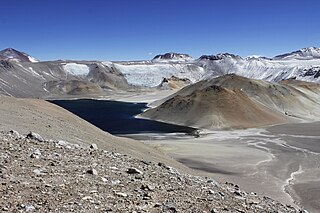
Incapillo is a Pleistocene caldera, a depression formed by the collapse of a volcano, in the La Rioja province of Argentina. Part of the Argentine Andes, it is considered the southernmost volcanic centre in the Central Volcanic Zone of the Andes with Pleistocene activity. Incapillo is one of several ignimbritic or calderic systems that, along with 44 active stratovolcanoes, are part of the Central Volcanic Zone.

Sairecabur is a volcano located on the frontier between Bolivia and Chile. It is part of the Andean Central Volcanic Zone. Sairecabur proper is 5,971 metres (19,590 ft) high; other mountains in the range are 5,722 metres (18,773 ft) high Curiquinca, 5,819 metres (19,091 ft) high Escalante and 5,748 metres (18,858 ft) high Cerro Colorado, all of which have erupted a number of lava flows. Also in close proximity to Sairecabur lie the volcanic centres Licancabur, Putana and Juriques.

Nevado El Fraile also called Incahuasi Chico is a volcanic mountain in the Andes of Chile. It sits at the border of Argentina and Chile. Along with numerous other volcanic peaks in the region, including Ojos del Salado, the highest volcano in the world, it is part of the Central Volcanic Zone. The closest higher peak is Incahuasi, which is 7.9 kilometres (4.9 mi) to the east.
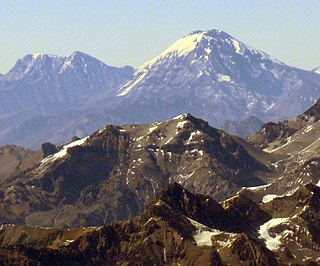
Ameghino is a mountain in Argentina. It has a height of 5,950 metres (19,521 ft).
Medusa is a mountain at the border of Argentina and Chile. It has a height of 6,130 metres (20,112 ft). It's located at Catamarca Province, Tinogasta Department, at the Puna de Atacama. At the Chilean side, its shares territories with the commune of Copiapó.
Cerro Polleras is a mountain in the Andes at the border of Argentina and Chile with an elevation of 5,993 metres (19,662 ft) metres. Polleras is within the Principal Cordillera of the Andes. Its territory is within the Argentine protected area of Tupungato Volcano Provincial Park. It is on the border of two provinces: Argentinean province of Mendoza and Chilean province of Cordillera. Its slopes are within the territory of two cities: Argentinean city of Luján de Cuyo and Chilean commune of San José de Maipo.
Volcan del Viento also called Gendarme Argentino 2 is a remote mountain in Argentina with an elevation of 6,028 metres (19,777 ft) metres. Volcan del Viento is within the following mountain ranges: Argentinean Andes, Puna de Atacama and Andean Volcaninc Belt. It is located at the Argentinean province of Catamarca. Its slopes are entirely within the territory of the Argentinean city of Fiambalá.
